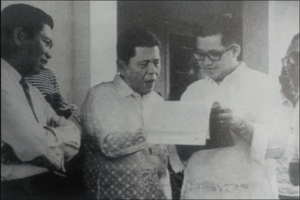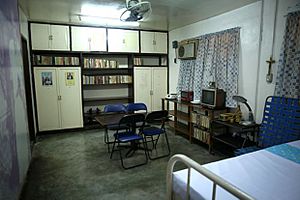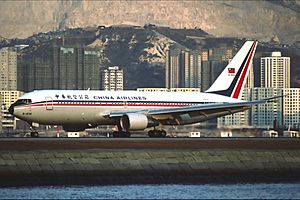Ninoy Aquino facts for kids
Quick facts for kids
Ninoy Aquino
QSC CLH KGCR
|
|
|---|---|
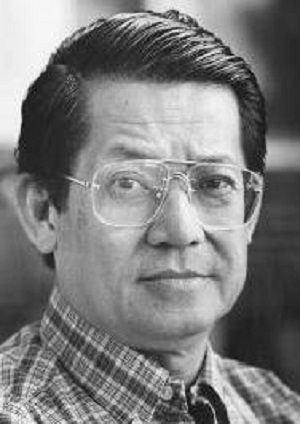
Aquino c. 1980s
|
|
| Senator of the Philippines | |
| In office December 30, 1967 – September 23, 1972 |
|
| Governor of Tarlac | |
| In office February 17, 1961 – December 30, 1967 |
|
| Preceded by | Arsenio Lugay |
| Succeeded by | Danding Cojuangco |
| Vice Governor of Tarlac | |
| In office December 30, 1959 – February 15, 1961 |
|
| Mayor of Concepcion, Tarlac | |
| In office December 30, 1955 – December 30, 1959 |
|
| Preceded by | Nicolas Feliciano |
| Succeeded by | Romeo Yumul |
| Presidential Adviser on Defense Affairs | |
| In office 1949–1954 |
|
| President | Elpidio Quirino Ramon Magsaysay |
| Personal details | |
| Born |
Benigno Simeon Aquino Jr.
November 27, 1932 Concepcion, Tarlac, Philippine Islands |
| Died | August 21, 1983 (aged 50) Manila International Airport, Metro Manila, Philippines |
| Cause of death | Assassination |
| Resting place | Manila Memorial Park – Sucat, Parañaque, Philippines |
| Political party | LABAN (1978–1983) Liberal (1959–1983) Nacionalista (until 1959) |
| Spouse | |
| Children | 5, including Benigno III and Kris |
| Parents | Benigno Aquino Sr. Aurora Aquino |
| Relatives | Aquino family |
| Alma mater | Ateneo de Manila University University of the Philippines Diliman |
| Occupation | Politician |
| Profession | Journalist |
| Signature |  |
Benigno "Ninoy" Simeon Aquino Jr. (born November 27, 1932 – died August 21, 1983) was an important Filipino politician. He served as a senator of the Philippines from 1967 to 1972 and was also the governor of Tarlac province.
Ninoy Aquino was married to Corazon Aquino, who later became the 11th president of the Philippines after his death. He was also the father of Benigno Aquino III, who became the 15th president. Ninoy Aquino was a strong leader who spoke out against President Ferdinand Marcos.
After Marcos declared martial law in 1972, Ninoy Aquino was arrested. He was held in prison for seven years. He became known as the most famous political prisoner during Marcos's rule. In 1980, he was allowed to travel to the United States for medical treatment. While in the US, he continued to criticize the Marcos government.
As the situation in the Philippines got worse, Aquino decided to return home. He wanted to help bring back democracy. Sadly, he was shot and killed at Manila International Airport on August 21, 1983, when he arrived. His death sparked huge protests against Marcos. It also led his wife, Corazon, to run for president in 1986, which she won.
Today, the Manila International Airport is named Ninoy Aquino International Airport in his honor. The anniversary of his death is a national holiday in the Philippines.
Contents
Ninoy Aquino's Early Life and Career
Ninoy Aquino was born Benigno Simeon Aquino Jr. in Concepcion, Tarlac on November 27, 1932. His father, Benigno Aquino Sr., was a senator. His mother was Aurora Lampa Aquino. His family owned large farms.
His grandfather, Servillano Aquino, was a general in the army of Emilio Aguinaldo, the first president of the Philippines.
Ninoy went to different schools, including De La Salle College and San Beda College. He studied at Ateneo de Manila University and later at the University of the Philippines Diliman. At 17, he became the youngest war reporter covering the Korean War. For his reporting, he received an award called the Philippine Legion of Honor.
At 21, he became a close adviser to Defense Secretary Ramon Magsaysay. In 1954, President Magsaysay asked him to talk to Luis Taruc, a rebel leader. After four months, Taruc surrendered, and Aquino received another award.
In 1955, at just 23 years old, he became the mayor of Concepcion.
Ninoy Aquino's Political Journey
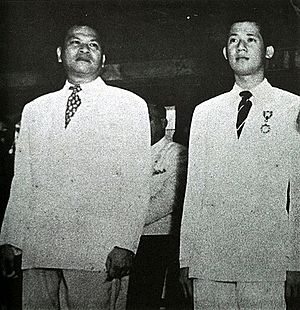
Ninoy Aquino grew up knowing a lot about Philippine politics. His family was well-known in politics and owned land. This helped him get elected as mayor at a young age. He became the youngest vice governor at 27. Then, in 1961, he became the governor of Tarlac province. In 1966, he became a leader in the Liberal Party.
In 1968, as a senator, Aquino started to criticize President Marcos. He said Marcos was spending too much on the military. He also claimed Marcos was putting military people in charge of civilian government jobs.
Aquino became famous for speaking out against Marcos. He gave a strong speech on February 10, 1969, criticizing the Cultural Center of the Philippines. This center was a project of the First Lady, Imelda Marcos. Aquino called it "a monument to shame." President Marcos was very angry and called Aquino "a congenital liar."
A major event happened on August 21, 1971, at the Plaza Miranda bombing. This was a rally for the Liberal Party. Two explosions happened, killing eight people and injuring many others. Aquino was not there, which made some people wonder if he knew about it beforehand. No one was ever punished for the attack. Many historians believe Marcos might have been involved to create an excuse for martial law. Other historians suggest a different group was responsible.
Life During Martial Law
Marcos declared martial law on September 21, 1972. Ninoy Aquino and other opposition leaders were among the first to be arrested. They were put in Fort Bonifacio on false charges.
On April 4, 1975, Aquino began a hunger strike. He wanted to protest the unfair military trial he was facing. For 40 days, he only had salt tablets, amino acids, and water. His family and friends prayed for him. On May 13, 1975, he ended his fast, feeling he had made a strong statement.
He remained in prison, and his trial continued for years. Aquino argued that the military court had no right to try him. On November 25, 1977, the military court found Aquino guilty and sentenced him to death. However, Marcos changed the sentence due to international pressure about human rights.
1978 Election and Health Issues
In 1978, while still in prison, Aquino was allowed to run in the 1978 Philippine parliamentary election. He formed a party called Lakas ng Bayan. All of his party's candidates, including Ninoy, lost the election.
In March 1980, Aquino had a heart attack while in solitary prison. He had a second heart attack at the hospital. Doctors found a blocked artery. Filipino surgeons were worried about operating on him because of the political situation. Aquino also feared Marcos's influence. He wanted to go to the United States for surgery.
His request was approved, and Ninoy went to the US with his family. This was arranged after a secret visit from Imelda Marcos. It was agreed that he would return and not speak against Marcos. However, after his successful surgery, Ninoy said he would not keep his promise. He said, "a pact with the devil is no pact at all."
He, his wife Cory, and their children started a new life in Massachusetts. He wrote books and gave lectures at Harvard University and MIT. He traveled across the US, giving speeches against the Marcos government. Even though he enjoyed his peaceful life in America, Aquino always planned to return to the Philippines.
Planning His Return to the Philippines
In early 1983, Aquino heard that the political situation in the Philippines was getting worse. He also heard that President Marcos was very sick. Aquino believed he needed to talk to Marcos. He wanted to convince him to bring back democracy before things got out of control. His friends worried that without his leadership, the opposition would weaken.
Aquino decided to go back to the Philippines, even though he knew it was dangerous. People warned him he might be imprisoned or killed. Aquino replied, "if it's my fate to die by an assassin's bullet, so be it." His family's passports had expired, and the government refused to renew them. So, they planned for Aquino to fly alone.
Aquino got a passport with a fake name, "Marcial Bonifacio." He also got a real passport from a supporter. The Marcos government warned airlines not to fly Aquino to the Philippines. But Aquino insisted it was his right to return home. He left the US on August 13, 1983, and traveled through Los Angeles, Singapore, Hong Kong, and Taipei.
From Taipei, he flew to Manila on China Airlines Flight 811. Marcos wanted Aquino to stay out of politics. But Aquino said, "the Filipino is worth dying for." He wanted to ask Marcos to step down peacefully. He knew the risks. He told journalists on the plane, "You have to be very ready with your hand camera because this action can become very fast." His last interview was on the plane just before he was killed.
In his final statement, which he could not deliver, he said he returned "to join the ranks of those struggling to restore our rights and freedoms through non-violence."
Ninoy Aquino's Assassination
Ninoy Aquino was shot and killed on August 21, 1983, as he returned to the Philippines. About 1,000 security personnel were supposed to protect him. But they did not stop the killing. Another man, Rolando Galman, was also shot dead. The Marcos government falsely claimed Galman was the killer.
An investigation led to charges against 25 military men and one civilian. They were found not guilty in 1985. However, the Supreme Court later called this a "mock trial" ordered by Marcos.
After Marcos was removed from power, another investigation found 16 soldiers guilty. They were sentenced to life in prison in 1990. Some were later released.
Aquino's death led to a big increase in opposition to Marcos. In the 1984 parliamentary election, the opposition won many more seats than before.
Ninoy Aquino's Funeral
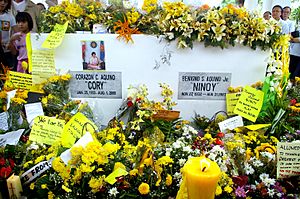
Aquino's wife, Corazon Aquino, and their five children arrived the day after he was killed. His funeral procession on August 31, 1983, was huge. It started at 9 a.m. with a mass and lasted until 9 p.m. when his body was buried. More than two million people lined the streets to pay their respects. Only a few radio stations covered the entire event.
Ninoy Aquino was buried at the Manila Memorial Park in Parañaque.
Ninoy Aquino's Legacy
Ninoy Aquino was seen as a very important and active politician of his time. Before martial law, some thought he was just another politician from a powerful family. But during his seven years and seven months in prison, he had a spiritual change. He read a book called Born Again and it inspired him.
After this, his life and politics became more spiritual. He became like Jose Rizal, a national hero, who also believed in using peaceful ways to fight against unfair rule. He followed the ideas of leaders like Mahatma Gandhi and Martin Luther King Jr..
Many students who fought against Marcos initially saw Aquino as a typical politician. But they changed their minds when he risked his life to return to the Philippines. They realized he was more than that when he paid the ultimate price for his choice.
Monuments and Memorials for Ninoy Aquino
The Manila International Airport, where he was killed, was renamed Ninoy Aquino International Airport (NAIA). His picture is also on the 500-peso note with his wife.
On February 25, 2004, a law was signed making the anniversary of his death an annual special non-working holiday in the Philippines.
Several statues have been built to honor him. One is a bronze statue in Makati. Another is in front of the Municipal Building in Concepcion, Tarlac.
The main library of the Polytechnic University of the Philippines is also named the Ninoy Aquino Library and Learning Resources Center in his honor.
Ninoy Aquino's Personal Life
On October 11, 1954, Ninoy Aquino married Corazon Sumulong Cojuangco (Cory). They had five children:
- Maria Elena ("Ballsy")
- Aurora Corazon ("Pinky")
- Benigno Simeon III ("Noynoy"), who became the 15th President of the Philippines
- Victoria Elisa ("Viel")
- Kristina Bernadette ("Kris")
Ninoy Aquino was raised Catholic. He said his religious journey became stronger after reading a book while in prison.
See also
 In Spanish: Benigno Aquino para niños
In Spanish: Benigno Aquino para niños


